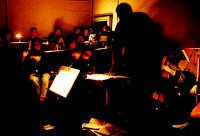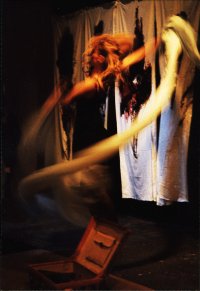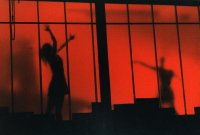Performance
 »Before you change the cutting wheel, do a sound check...«
»Before you change the cutting wheel, do a sound check...«
Final performance of the 1st International Orchestra Academy Dortmund
Members of the National Philharmonic Orchestra Brasov, Rumania
Ovidiu Dan Chirila, conductor
Members of the »Theatre in the warehouse«
Christian Jendreiko, director
Birgit Götz, choreography
Regine Birkner, Sophie Hausdorf, Gabriele Musebrink, Kerstin Weyand, painting
Hans-Joachim Hessler, overall artistic direction
31.10.1997
Theatre in the warehouse, Dortmund
 The changeful story of the FILHARMONICA "G. DIMA" BRASOV (National Philharmonic Orchestra Brasov, Rumania)
goes back to the 18th century. Already back in 1756, there are reports of a Collegium musicum that is
highly popular in the capital of Transylvania. In 1878, the "Philharmonic Society Brasov" appears publicly
for the first time. On a semi-professional level, this orchestra becomes the regional
pioneer of symphonic music.
The changeful story of the FILHARMONICA "G. DIMA" BRASOV (National Philharmonic Orchestra Brasov, Rumania)
goes back to the 18th century. Already back in 1756, there are reports of a Collegium musicum that is
highly popular in the capital of Transylvania. In 1878, the "Philharmonic Society Brasov" appears publicly
for the first time. On a semi-professional level, this orchestra becomes the regional
pioneer of symphonic music.
After the First World War, the orchestra's sphere of influence expands, under the direction of the pianist,
composer and conductor Paul Richter, to the whole of Rumania. In 1949, the orchestra is taken under the sponsorship
of the government. In the following years, the now professional sounding body "National Philharmonic Orchestra Brasov"
completes its repertoire as well as its musical capability and develops to one of the leading Ensembles
of southeastern Europe.
 Hans-Joachim Hessler chose the pieces Le Différend XVII and Le
Différend XXIII, both deriving from an open series of orchestra pieces with different instrumentation.
The title has been chosen in leaning on the master work with the same name of the French philosopher
Jean-François Lyotard, who believed that it was only possible to move forward through conflict
(French différend).
Hans-Joachim Hessler chose the pieces Le Différend XVII and Le
Différend XXIII, both deriving from an open series of orchestra pieces with different instrumentation.
The title has been chosen in leaning on the master work with the same name of the French philosopher
Jean-François Lyotard, who believed that it was only possible to move forward through conflict
(French différend).
In Le Différend XVII, after a »beautiful« intro by the strings, the wind section accrues and opens
the discourse between the two instrumental groups. This »conflict« continues throughout the entire piece.
In an aleatoric middle part, every instrument has the possibility to offer the listeners an own form of discourse,
however these forms of discourse are not free of compulsion, so that they need to orientate themselves along
the trumpet, for instance, whose part has been written out.
Sound example
 In Le Différend XXIII, concise rhythms contrast with sound deferrals, within which the groups of
instruments stand in discourse with one another. In this partly harmonic, partly disharmonic network of sound,
up to nine forms of discourse face one another, in the parts that emphasize rhythm there are two of them.
Here, the instruments of the lower positions »dispute« with those of the higher positions.
In Le Différend XXIII, concise rhythms contrast with sound deferrals, within which the groups of
instruments stand in discourse with one another. In this partly harmonic, partly disharmonic network of sound,
up to nine forms of discourse face one another, in the parts that emphasize rhythm there are two of them.
Here, the instruments of the lower positions »dispute« with those of the higher positions.
Sound example


